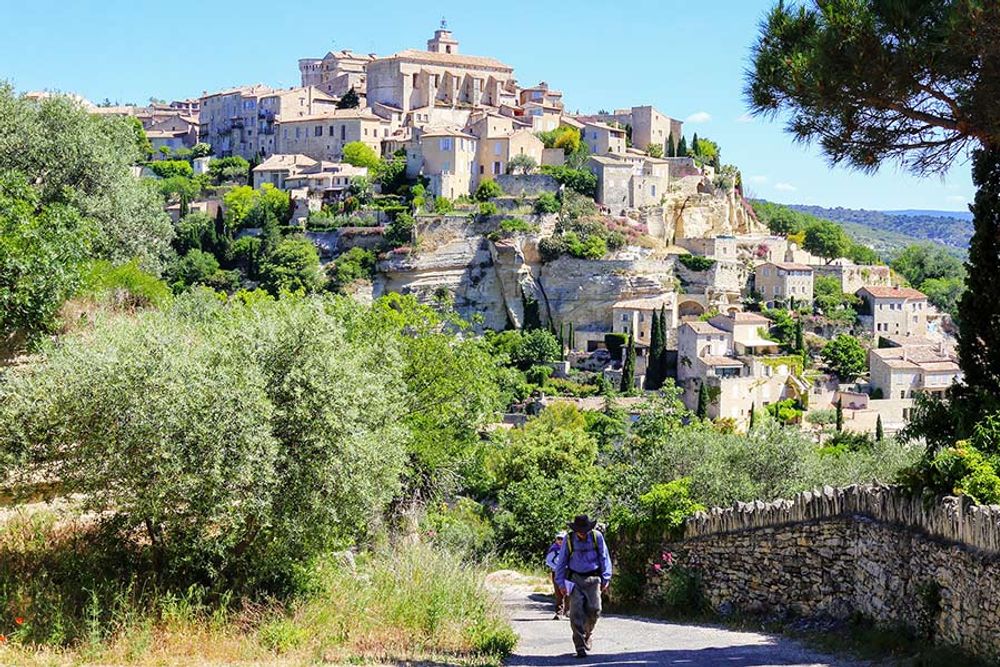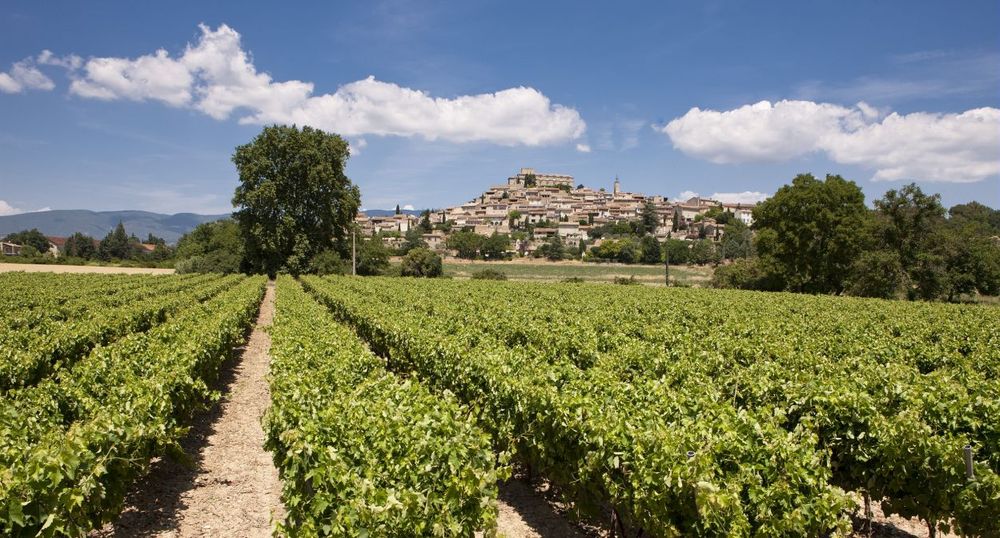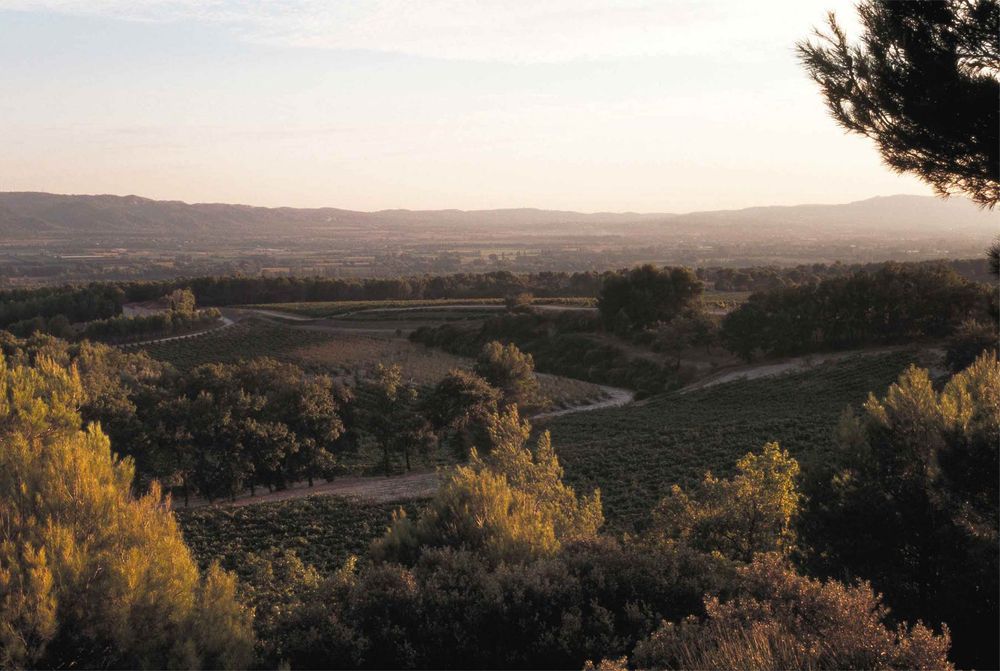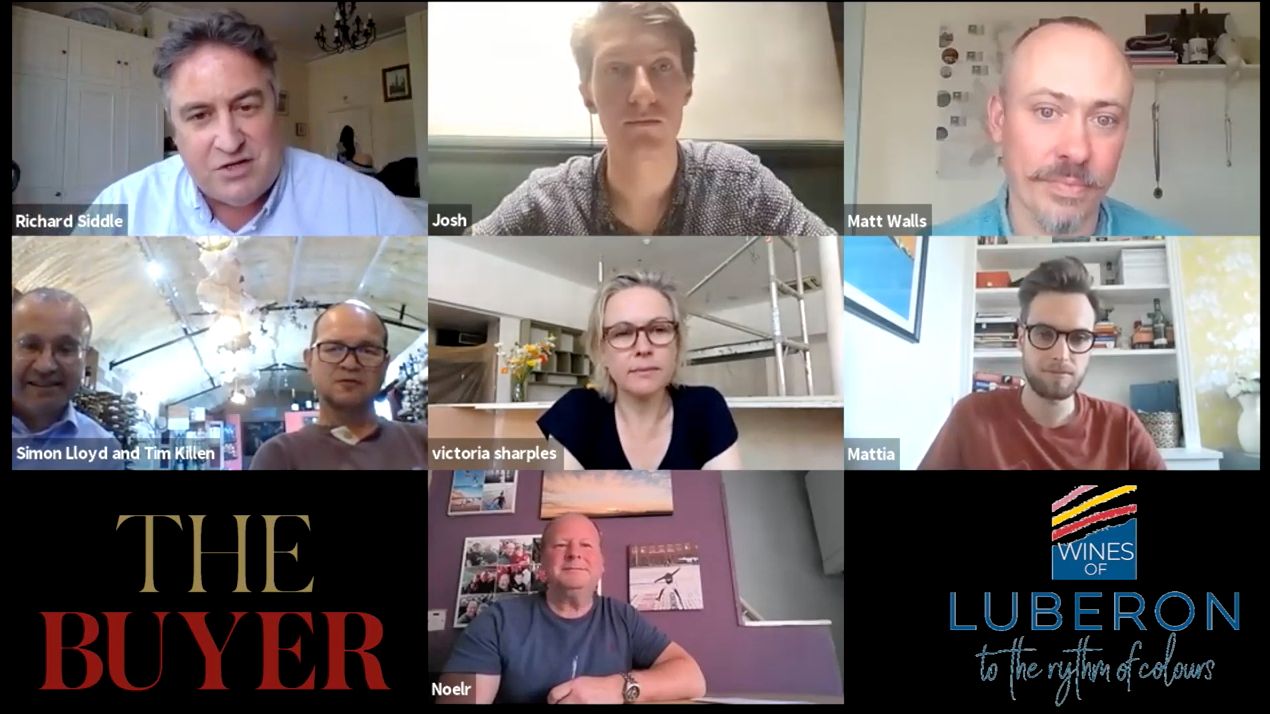Is there a standout style of wine from Luberon? Does it have a particular identity for buyers to latch on to? These were just some of the themes the panel discussed in the first part of The Buyer’s latest debate that looked at the overall region, before assessing its rosé wines in particular. Part two will be published later in the week.
The Buyer and Wines of Luberon would like to thank our buyers’ panel for their time in taking part in the debate. They include:
- Victoria Sharples, wine consultant, opening new wine bar in Lower Highgate, north London.
- Noel Reid, founder of Rediscover Wines.
- Tim Killen, business development manager, Alpine Wines
- Joshua Castle, head sommelier, Noble Rot
- Simon Lloyd, director, Lloyd Wines
- Mattia Scarpazza, head sommelier, Petersham Nurseries
- Matt Walls, wine writer, and specialist in Luberon wines
(To watch the full debate click below)
“Freshness”, “drinkability”, “personality”, “refreshment”…just some of the descriptions that kept coming up time and again as our panel of buyers got to grips with just what it was for them that stood out from the Luberon wines they were able to taste during our session.
They are also arguably not the four descriptors you would expect to hear as part of a wider debate looking at the Rhône in general. For whilst the Luberon might technically be part of the Rhône, so many of its characteristics would be more at home just across the wine border in Provence.
That was certainly one of the key messages that wine writer Matt Walls wanted to get across in his opening talk on what he thinks makes the Luberon such a fascinating and important wine region for buyers to understand. A region that is often overlooked when buyers head to the Rhône, and what are the more high profile treasures to be found in the north.
It’s a region, he said, he only really got to fully understand and get to grips with when he moved to Rhône with his young family for a couple of years in order to write his book – Wines of the Rhône which was published earlier this year.
Key points of difference
If you could do with a Luberon refresher yourself then here are Walls’ key factors in what makes it stand out. Click on the link to watch.
- The Luberon appellation was only set up in 1988 and now covers around 3,300 hectares, at 200m to 500m altitude, of which 14% are organic production with 48 hectolitres per hectare on average, with 2,000 hours of sunshine a year.
- The majority of production is rosé (59%) and although white wines, which have to be a blend, account for 18% which is twice the average for the Rhône (10%) and red wines 23%.
- All the vineyards in the Luberon are part of a protected natural park covering 36 communes with a rich variety of flora and fauna, with lavender, cherry, oak and almond trees.
- The sharp differences between day and night temperatures, which are for more than they are inthe rest of the Rhône, thanks to the influence of the Alps and help contribute to the freshness in all its wines, reds included.
- White wines are markedly different from the rest of the Rhône thanks to the large plantings of Vermentino, which also helps bring zesty, fresh, citrus notes to the wines.
- Value for money. This is the part of the Rhône to come to for good quality, well priced wines, with most between £10 to £20.
- It’s only been since 1981 that private domaines have started to make their own estate wines, and there are currently around 60 private domaines, 10 co-operartives and 13 negociants.
- It’s also a tourist’s dream, looks stunning and was actually the backdrop to Peter Mayle’s stories of life in the south of France and where the Ridley Scott film A Good Year was filmed.
So dig below the surface and there is a lot to single Luberon out as a premium wine producing region, stressed Walls, who is pleased to see it “gaining more traction” and “notoriety” amongst wine professionals. It does, though, still have some way to go before consumers recognise it as a standalone wine region as they do other areas of the Rhône – even though it is such a hugely popular tourist destination.
A region that is also fiercely proud of its traditions and this is not an area that for a lot of natural winemaking. Instead producers are likely to follow more conventional winemaking practices, even with more vines going over to organic production, and a wider use of Diam corks.
“It goes to show that they care about the quality and how the wine presents itself and care about the consumer experience, which is all very positive,” said Walls.
(Click here for Alpine Wines’ Tim Killen & Lloyds Wines’ Simon Lloyd on the big potential for Luberon Wines in the UK)
First impressions
Before the panel of buyers had the chance to taste the wines, they were asked to share their first impressions and perceptions of what the Luberon means to them.
Mattia Scarpazza, head sommelier at Petersham Nurseries, said he visited the region a couple of years ago and has subsequently been “buying and trying different” wines and is particularly drawn to their “freshness”. “It’s a very interesting style that sits somewhere between southern and northern Rhône and they do have this uniqueness to them,” he added.
Victoria Sharples, who knows the region well from her time buying wine for St John Wine and restaurant group, said it is certainly an area she would consider for her new wine bar she is due to open shortly near Hampstead Heath. Although she knows the region produces a lot of rosé she does not usually factor it in when looking to buy rosé, but instead sees it as a great source for fresh red wines. That’s what stands out for her.
“It’s sort of Côtes du Rhône with a difference and they are always very good value for money from what I have seen,” she added. Sharples, though, was particularly interested to see how the Vermentino would perform as she has been impressed by how well it has done in other areas of southern France.
Noel Reid, who has just set up his own agency business, Rediscover Wines, said he also does not associate the Luberon with rosé wines, but instead, because it is part of the Rhône, would expect to go there to source red wines and that’s certainly the perception that consumers would have.
Joshua Castle, head sommelier at Noble Rot, said he immediately associates the region with quality wines, and that he would describe them as “definitely hand sell wines”. But otherwise he has a pretty open mind as it does not immediately have the reference points to latch on to that other fine wine regions have. Be it famous, “cult” producers to get behind or stand out labels, that can then influence other wineries in the region.
Celebrating up and coming wine producers

Luberon has long been a major tourist attraction for its beautiful landscape and hillside towns
Tim Killen, business development manager at Alpine Wines, said the Luberon really fits nicely into the philosophy and buying principles of what it looks to do in trying to find off beat, and not widely known wines and then find a route for them in the UK market. Yet there is a strange dichotomy between the large amount of Brits that might travel to the region, and yet not actually know they are in the Luberon to recognise the region when they are back home buying wine.
That said it “scores” highly with buyers, particularly specialist wine restaurants, bars and merchants, as it seen as “somewhere a little different,” said Killen. Even for those operators that are not looking to take on new suppliers, they see the Luberon as being different enough to really draw attention and engagement with their customers. “If there is a different story and different style of wine then consumers are becoming more curious. It’s not just another Côtes du Rhône, there are a lot of USPs.”
He added: “It requires quite a lot effort to go out and talk about the stories and the freshness and the diurnal range,” he says, but that’s a commitment that Alpine are prepared to make as they believe so much in the quality and value of the wines. “We’ve had huge success [with them]”.
The challenge for the on and off-trade is how you tap into the “holiday experience” that people have of the region. “Now is a brilliant time to do that for the Luberon because there are an awful lot of people not going to France,” said Killen.
Simon Lloyd, director of Lloyd Wines, is already a big fan of Luberon wines, and had a number of wines in its range when it ran its own business in France itself. The challenge, he said, for UK buyers and merchants is actually finding and getting access to Luberon wines, but the potential and interest is most definitely there.
Different wine styles
The panel was able to assess good examples of Luberon wines and styles by going through two rosés, two whites and two reds. The full selection was as follows:
- Marrenon Petula 2020 (rosé)
- Chateau la Verrerie 2020 (rosé)
- Marrenon Doria 2019 (white)
- Domaine Bastide du Claux-Barraban 2019 (white)
- Chateau la Verrerie-Hautes Collines 2017 (red)
- Chateau de la Canorgue 2019 (red)
Luberon Rosés
(Click here for Victoria Sharples, Noel Reid and Matt Walls on Luberon on the appeal of rosé wines)
The panel first turned its attention on the rosé opportunities from Luberon and how it could potentially become a good source of quality, good value rosé at a time when they are becoming increasingly harder to find.
Overall the buyers were pleased with the two rosés they were able to taste and felt they were a good representation of what is possible from the Luberon. Joshua Castle was pleased to see the colour come through on the rosés as well. “For the UK market, colour does matter.”
Sharples felt there were characteristics in the rosés that actually give them an edge on some classic Provence styles. The fact they had read depth, to go along with their freshness and acidity made them both good food wines, but also wines you can enjoy at any time of the day – or year. That’s key for Sharples. Rosés that work 12 months of the year.
She was delighted to find “real, delicious rosés” that perform like serious wines in their own right rather than just a “quaffable rosé” style. The fact they are so close to Provence and yet most definitely not the same was a good selling point to really play on, she added. Particularly if there are shortages from Provence, it’s a great opportunity for Luberon to step in.
Walls agreed there was definitely a pull from the south and a strong Provence influence with the rosés and that in some of the most southern parts of the region they are effectively in Provence. The Rhône effect is far more pronounced when it comes to Luberon’s reds and whites, he added.
Points of difference

The Luberon offers a wide selection of quality wines that deserve wider recognition, said the panel of buyers
The buyers recommended Luberon to do what it can to both associate itself but also put some distance as well between its close neighbours in Provence.
It’s a delicate balance to get right but positioning its wines as coming from a very distinct and specific region, whilst also putting it in context with where it is would be a strong commercial move to make.
The opportunity is very much there, said Reid, as the quality of the Luberon wines stand up, it’s just using words and descriptors that help consumers understand where the Luberon is. Don’t shy away from the Provence association, but make sure you push and promote Luberon’s credentials and point of different to the full, he stressed.
“Help consumers understand how good your wines are. The wines are lovely. They are very good,” said Reid.
(Click here for Alpine Wines’ Tim Killen & Lloyds Wines’ Simon Lloyd on the Peter Mayle effect and Luberon’s positioning vs Provence)
Then there is the Peter Mayle factor and the author who unwittingly made the region a tourist trap with his ironically titled book “A Year in Provence” when it was actually the Luberon where he lived.
“People have read the book or seen the movie and they are weathered to that image, but they don’t care about the classification or appellation, in their mind that’s Provence where they might see Marion Cotillard and Russell Crowe prancing around and all the lavender fields. So maybe we are missing a trick,” added Killen who suggested promoting them as “wines from The Good Year country”. “What’s not to like about that?”
“I think the Luberon could be described as being Provencal. It’s not in AOC or Aix en Provence, for example,” he added.
Scarpazza said perhaps one of the reasons why we don’t get to see as many of the Luberon rosés in the UK as we would like is because they are largely made by the co-operatives who are happy to mainly supply the French supermarkets and other local French markets.
Walls agreed and said it was certainly the co-operatives rather than the private estates that had seen the commercial opportunity with rosé, leaving the domaines to focus far more on their white and red wines.
Castle said a key consideration for him when tasting and looking at rosés is whether or not they would perform by the glass as that is a real factor in whether Noble Rot would list them. So a sweet spot for him would be dry Provence style rosé that it could sell £6 to £10 by the glass on its list. That’s what the Luberon needs to keep in mind, he stressed, and look to compete in that area.
But based on the Luberon rosés he tasted, Castle was confident there was the quality and price to be found in the Luberon and a very distinct and different style to be proud of and to push and promote.
Tasting the wines
Marrenon Petula 2020 (rosé) (not available in the UK)
Marrenon is a union of eight co-operatives across Luberon and Ventoux that produces a wide range of quality wines. The Petula 2020 offers particularly good value, said Matt Walls, at around £10 retail or a little below. This is a good example of the fresh, fruity, well made balanced rosés you find in the Luberon, he added. “This is classic of what you would expect from an inexpensive Luberon.”
“I think the quality is really there,” said Castle at Noble Rot.“The colour is really appealing and the profile of the wine has enough fleshiness, but is also finishing really nice and dry. A really lovely wine.”
“You have got all the red fruits there, but you have got a lot of creamy mouthfeel which you tend to put across with Provence. Then you have got the sweet ripe fruit which is very attractive and then it just goes to an extra level,” added Sharples. “For entry level it is over delivering.”
Reid was also very taken with the wine and felt it had the right balance of fruit, sweetness and minerality to really appeal to consumers. “It has a finesse without being too heavy. It’s pretty good.”
Chateau La Verrerie 2020 (rosé) (DTC in France €11.50, UK around £20 retail)

Chateau Le Verrerie makes red, white and rosé wines
One of the first private domaines in the region located west, close to the Rhône river, with around56 hectares and produce a wide range of wines from entry level up to €30 plus.
Again a well balanced rosé with “good freshness,” said Walls “but with a bit more depth and length on the fruit” which would work well with a light meal.
Sharples said she was drawn in by the nose initially and then taken with its “beautiful length and really good acidity”. “This at £20 does not scare me compared to some of the Provence rosés I have seen at that price. This has got real character, lovely depth and I would drink that all day and all night. It’s a pre, during and after rosé.”
That’s where the depth in the wine really makes it stand out, added Walls. A rosé you can also drink all year round, said Sharples, who also singled out this wine for its “really smart packaging”
Killen felt a £20 price point was “spot on” for a rosé with all the “meaty texture” you want in a quality rosé.
But again this is where Reid felt, with his commercial hat on, a Luberon rosé could fall down, as £20 would still be a lot of money for a rosé from a not well known area. “I agree it is a really interesting wine, but it is how you sell that wine and you need hands on expertise to do so otherwise most people won’t get chance to taste it,” said Reid.
Scarpazza agreed on both points. He thought it was a “beautiful” wine that was “rounded and very precise” with “fantastic” fruit and although he agreed it was certainly worth £20 it would need someone to hand sell it to a customer.
- In part two of our Luberon report we will focus in what the buyers thought of the region’s red and white wines and their overall summary of the region.































